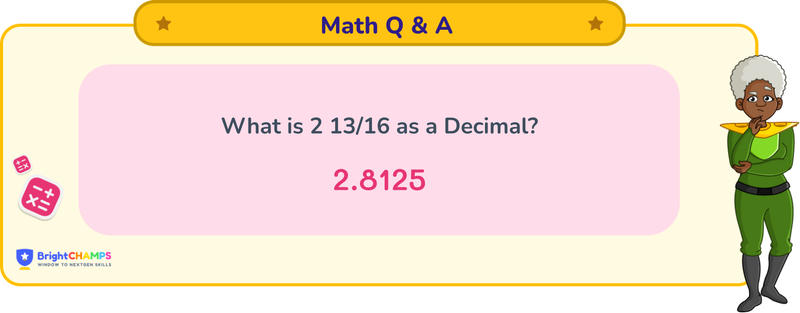Summarize this article:
 219 Learners
219 LearnersLast updated on August 5, 2025
2 13/16 as a Decimal

It is a simple question on decimal conversion. Firstly, we have to learn fractions and decimals. A fraction represents a part from the whole. It has two parts: the numerator (number on the top), here representing how many parts out of the whole, and the denominator (number below), which shows how many parts make the whole. A decimal is a way to represent a number that is not whole, using a decimal point (.) to separate the whole part from the fraction part. The numbers to the left of the decimal point represent the whole, and those to the right represent the fractional part.

What is 2 13/16 as a decimal?

Answer
2 13/16 in decimal form can be written as 2.8125. It is a terminating decimal.
Explanation
To convert 2 13/16 into a decimal, we first convert the fractional part 13/16 to decimal using division, and then add it to the whole number 2. Let's see the step-by-step breakdown of the process.
Step 1: Identify the whole number part (2) and the fractional part (13/16).
Step 2: Convert the fractional part 13/16 to a decimal.
Step 3: Divide 13 by 16.
Step 4: 13 is smaller than 16, so we use decimal division. Add a decimal point and zeros to 13 to make it 130, and start dividing.
Step 5: 16 goes into 130 eight times (16 × 8 = 128), leaving a remainder of 2.
Step 6: Bring down another 0, making it 20.
Step 7: 16 goes into 20 once (16 × 1 = 16), leaving a remainder of 4.
Step 8: Bring down another 0, making it 40.
Step 9: 16 goes into 40 two times (16 × 2 = 32), leaving a remainder of 8.
Step 10: Bring down another 0, making it 80.
Step 11: 16 goes into 80 five times (16 × 5 = 80), leaving no remainder. The fractional part 13/16 as a decimal is 0.8125.
Step 12: Add the whole number 2 to the decimal 0.8125, resulting in 2.8125.
Thus, 2 13/16 as a decimal is 2.8125.

Important Glossaries for 2 13/16 as a decimal
- Fraction: A numerical quantity that is not a whole number, representing a part of a whole.
- Decimal: A number that uses the base ten and includes a decimal point to separate the whole part from the fractional part.
- Mixed Number: A whole number and a proper fraction combined, such as 2 13/16.
- Terminating Decimal: A decimal that ends and does not repeat infinitely, such as 2.8125.

Explore More math-questions
![Important Math Links Icon]() Previous to 2 13/16 as a Decimal
Previous to 2 13/16 as a Decimal
![Important Math Links Icon]() Next to 2 13/16 as a Decimal
Next to 2 13/16 as a Decimal





